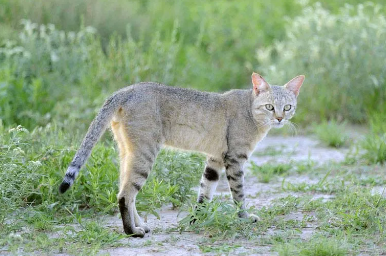The African wild cat is a fascinating species, often known as the ancestor of the modern domestic cat. Found across various regions of Africa, these cats play a crucial role in the ecosystem as stealthy predators. They have been revered in African cultures for centuries, and their names hold deep significance in terms of heritage, biology, and conservation.
This article delves deep into the various names associated with the African wild cat names, exploring their meanings, origins, and cultural significance. We will also discuss the scientific classifications, providing an in-depth understanding of the African wild cat from a biological perspective. Additionally, we will include a comprehensive table and images to enhance your understanding of this enigmatic feline species.

1. What Does the African Wild Cat Name Mean?
The name “African wild cat” is both a reflection of the species’ geographical habitat and its natural behaviors. As a wild feline native to Africa, this cat is primarily found in savannahs, grasslands, and forests. Its name is not just a label but a reflection of its characteristics:
- Wild: Unlike domesticated cats, these cats live independently in the wild, hunting for their food and surviving without human intervention. Their wild nature makes them essential to African wildlife.
- African: Indigenous to Africa, the African wild cat is spread across a vast region, from the southern tip of South Africa to the deserts of Morocco.
The names of the African wild cat vary depending on the local dialects, cultural references, and biological classifications. In African languages, these names often convey deeper meanings, indicating the cat’s behavior, its status as a predator, and even its spiritual significance in some cultures.
2. African Wild Cat Names
African wild cats have numerous names, depending on the region, language, and cultural context. Below are some of the most well-known names for this species:
- Mau – In Egyptian culture, the African wild cat is often referred to as “Mau.” The name is derived from the sound that cats make, and it’s believed that the Egyptian Mau breed descends directly from the African wild cat. The name Mau signifies not just the cat but a deeper connection between the feline species and the ancient Egyptian gods.
- Mphaka – This is a common name for the African wild cat in Southern Africa, particularly in languages like Tswana, Sotho, and Zulu. The word Mphaka refers to both wild and domestic cats, reflecting the relationship between humans and felines in traditional African societies.
- Ntsu – In Swahili, the African wild cat is often called “Ntsu.” This name highlights the cat’s sharp hunting abilities and its reputation as a fierce predator of small mammals and birds in the wild.
- Felis Africana – This is a scientific term, often used in African conservation circles, reflecting the species’ Latin roots. However, the common folk may use simpler vernacular names when referring to this wild feline.
These names, though diverse, carry a common theme of respect and reverence for the African wild cat as a symbol of agility, independence, and strength.
3. African Wild Cat Scientific Names
The scientific classification of the African wild cat is based on a detailed analysis of its evolutionary history, biological traits, and behaviors. Known as Felis lybica, this name distinguishes it from other members of the genus Felis.
Taxonomy Breakdown:
- Kingdom: Animalia
- Phylum: Chordata
- Class: Mammalia
- Order: Carnivora
- Family: Felidae
- Genus: Felis
- Species: Felis lybica
The term lybica is derived from the historical region of Libya, where early studies on the species were conducted. These cats are also related to other members of the Felis genus, including the European wildcat (Felis silvestris) and the Asiatic wildcat (Felis ornata).
4. African Wild Cat Common Names
While the scientific name categorizes this cat for academic purposes, it has several common names used throughout Africa. Depending on the country, region, and local language, people refer to it in diverse ways:
- Bush Cat – In rural African communities, the African wild cat is often called the “bush cat” due to its frequent habitation in bushlands, savannahs, and deserts.
- Desert Cat – In North Africa, particularly in arid regions such as the Sahara Desert, this cat is often referred to as the “desert cat,” indicating its adaptability to extreme climates.
- African Grey Cat – This term is used in some regions to describe the African wild cat’s grey coat, which helps it blend into the rocky and grassy environments of Africa.
Common Names of the African Wild Cat by Region
| Region | Common Name | Local Language | Meaning/Translation |
|---|---|---|---|
| Southern Africa | Mphaka | Tswana | Cat (wild or domestic) |
| Egypt | Mau | Egyptian | Cat (on a cultural and spiritual level) |
| East Africa | Ntsu | Swahili | Fierce predator |
| North Africa | Desert Cat | Arabic | Adapted to the desert environment |
| Central Africa | Bush Cat | Various | Living in bushland areas |
5. Latin Binomial Name for African Wild Cat
As previously mentioned, the Latin binomial name for the African wild cat is Felis lybica. This name forms part of the broader taxonomical classification, which helps scientists and researchers understand its place in the animal kingdom.
Subspecies
The African wild cat has several subspecies that are adapted to different environments across Africa. Each of these subspecies has slightly different characteristics, though they share a common ancestry:
- Felis lybica lybica – This subspecies is found in Northern Africa, particularly in arid desert regions.
- Felis lybica cafra – Also known as the Southern African wild cat, this subspecies inhabits Southern Africa’s savannahs and grasslands.
- Felis lybica pyrrhus – Found in Eastern Africa, this subspecies is known for its adaptability to a variety of habitats, from mountainous regions to woodlands.
6. Conclusion
The African wild cat is more than just a wild feline; it holds significant cultural, biological, and ecological importance. Its various names—whether scientific, common, or regional—are a testament to its adaptability and the deep connection between humans and cats throughout history.
7. FAQs
Q: What is the scientific name of the African wild cat?
A: The scientific name is Felis lybica.
Q: How many subspecies of African wild cats exist?
A: There are several subspecies, including Felis lybica lybica, Felis lybica cafra, and Felis lybica pyrrhus.
Q: Where can African wild cats be found?
A: They are found throughout Africa, in habitats ranging from deserts to savannahs.
Q: How is the African wild cat related to domestic cats?
A: The African wild cat is considered the ancestor of today’s domestic cats, with domestication dating back thousands of years.
Q: Are African wild cats endangered?
A: While not currently endangered, habitat loss and interbreeding with domestic cats pose significant threats to their population.






